T. rex ancestors migrated from Asia 70 million years ago
What's the story
A recent study led by Cassius Morrison, a paleontology doctoral student at University College London, has shed light on the origin of the Tyrannosaurus rex. The research suggests the direct ancestors of T. rex may have migrated from Asia to North America via a land bridge, around 70 million years ago. This theory aligns with previous studies indicating a closer genetic relationship between T. rex and Asian carnivore Tarbosaurus than with North American predators like Daspletosaurus.
Climate adaptation
Ancient climate and ecological conditions
Morrison's research suggests that when T. rex's ancestors roamed, the area was a temperate rainforest with a climate similar to modern-day British Columbia. He compared the ecological role of tyrannosaurids, T. rex's ancestors, to modern apex predators like lions. He explained that their rarity, in comparison to the herbivorous dinosaurs they preyed on, resulted in fewer chances for their preservation in the fossil record.
Research approach
Methodology and implications of the study
Since the fossil evidence is limited, Morrison and his team employed mathematical models that included data from existing fossils, climate, and the T. rex family tree. The modeling can be updated with new discoveries in future research. He mentioned that the findings of the new study indicate that fossils of these T. rex ancestors could still be undiscovered in Asia, opening up potential avenues for future research.
Evolutionary growth
T. rex's evolution and size increase
The study also noted that tyrannosaurids grew rapidly during falling global temperatures, indicating an adaptation to cooler climates. This growth coincided with the extinction of another group of large carnivorous dinosaurs called carcharodontosaurids, which left "a vacuum at the top of the food chain." By the time dinosaurs went extinct, T. rex could have weighed as much as nine metric tons, the equivalent of a very large African elephant or a light tank.
Expert opinions
Insights from the study coauthor and external expert
Study coauthor Charlie Scherer said their findings highlight how the biggest tyrannosaurs emerged in North America during the Cretaceous Period. They also explain why they grew so massive by the end of the age of dinosaurs. Paleontologist Steve Brusatte praised the study for tracking tyrannosaurs through time and comparing them with climate changes. He emphasized that even the largest and most dominant dinosaurs were influenced by weather, highlighting the role of climate in the evolution of T. rex's size.
